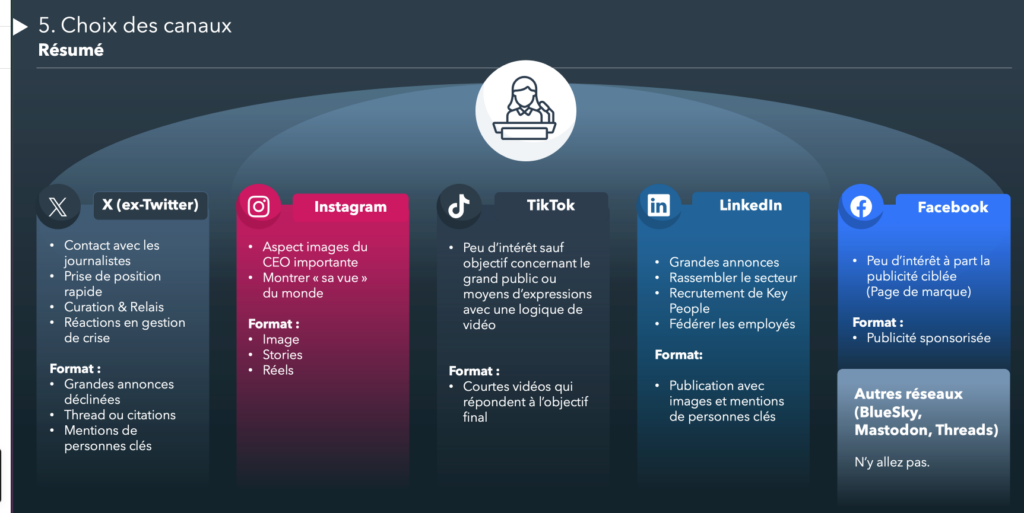Sommaire
How can you help managers establish their presence on social networks?
The leaders of major groups are increasingly feeling the call to speak out and the importance of existing. While they are sometimes still apprehensive about the aura, visibility and wide audience of the media, social networks are like a 'safezone' for embodying their role as the natural spokesperson for their company. We decided to share our knowledge in this area by isolating the plate tectonics.

However, they forget one key issue: this goes beyond simple institutional communication. It's about putting into words the concrete impact of choices, outlining perspectives, and becoming a beacon for employees in the darkness of their daily work. None of this is easy. So we're going to stretch the potential of speaking out on social networks.
The summary
- As far as the connection between social networks and CEOs is concerned, we're in two different worlds, with CEOs who don't have clear objectives and organisations that don't have the process or the experience to deal with these requests.
- However, this is going to become a must for future CEOs if they are to achieve their objectives in the 3 'extra-' areas. (Extra-financial, Extra-legal and Extra-reputational).
- Their vision is often truncated. Either over-interpreted or under-interpreted. The problem lies essentially in their own information practices or in the note-writing ecosystem of the people they meet, who will point more to traditional media than to social media, skewing the methods of constructing their opinion by
over-interpreting their own personal circles instead of understanding the circles by the objectives pursued. - The key objective is to find a "shared interest" and an "objective achievable through social networks" around the key areas of the CEO's medium and long-term action plan.
- The method must have a well-established target and set an editorial line that corresponds to the target and the objective being pursued.
- The indicators need to get away from the 'social media' indicators that don't speak to CEOs and shouldn't speak to anyone (apart from being guaranteed to give disappointing results). The number of publications on a subject, the number of engagements, the number of biased impressions in trillions: this is bullshit and will never speak to intelligent people who have to make a decision and understand the factual basis behind that decision.
I. Two different worlds
- This is it. The executive has made an important decision. He understands the value of communicating on his behalf. They're certainly not the first to do so, and they certainly have a frame of reference in mind (Nicolas Hieronimus, Michel-Edouard Leclerc, Xavier Niel).
- This is it. It's come out of the blue (or it's come from a global plan with a strategy that didn't stand a chance on paper), but the group's communications department or social media manager has received the request. You have to communicate within the group.
Normally, we've just seen a line-up. Both are ready. It's a Tinder match. Except that it's not.
- On the one hand, we have someone who is used to managing his entire organisation chart, his day-to-day life and his decisions on the basis of his skills and experience. He has a pedigree. Day-to-day legitimacy. On his fields, the CEO descends into the open space and crushes any junior in the company on any mission. Except that, in reality, on this field, he knows nothing. He's never done this before. He's never been taught this. He only reads the traditional media. He's incapable of giving the keys down, especially as we're talking to him about engagement, reach and all kinds of franglais words that don't make sense to him (and rightly so).
On the other, we have a communications department. There are three types:
- Those who have always considered social networks to be out of their league in the food chain. Social networks? The internets? It's at the end of the corridor in the team's open space. For these people, it's a total nightmare. Social networks are brought up on the assignment, with a clear indication that it will be managed by the person in charge. They quickly get in touch with an agency about the budget to make sure that the in-house team won't mismanage the project.
- The others who have always kept an eye on the networks. Generally the smartest of the bunch. They know that you have to be able to talk about it, but above all you mustn't pretend that you've mastered it for fear of being categorised as an 'internet wizard'. They are going to take the lead themselves, seeing it as a challenge.
- Those who came from there and who have finally worked their way up to the head of communications. In other words, they're not going to fall off the social networking bandwagon just when management finally wants to devote a bit of time, legitimacy and strategic interest to them. Another potential advantage is that they are already responsible for the social network communications of all the CEOs in the group they represent.
While there should be alignment, in the end there is none. They are not used to talking to each other and general practices are not standardised. Anybody involved in legal, management or financial matters is used to being in contact with the CEO's missions. But when it comes to extra-legal, extra-financial and extra-reputational issues (the 3 'extra-'s), it's an absolute blur.
In short, we have general processes for these fields which are relatively codified. And everything is time-bound (publication of quarterly financial results, dates of known court cases, etc.), whereas in the social sphere, everything can change overnight (change in a law or bylaw, reputational crisis, etc.), but this has a direct or critical impact.
II. The CEO
From what we've come across on these types of assignments, we've noticed certain typical patterns: (it should be pointed out, however, that this is a caricature or an agglomeration of things)
1. They have no objective
They're into checklists or intuition: you have to publish on social networks. They have no idea what the goal is other than to have an "aura". An aura is not an objective. Even in brand building and branding, nobody in marketing accepts a brief like that. However, the field is new: the individual brand has not yet been codified or theorised. However, it must respect the same general expectations, i.e. the definition of an objective, for a target, on a specific channel with key indicators.
2. They compare themselves
A corollary of the previous point, but as they have no objective, they will set benchmarks. In times of uncertainty and lack of knowledge, there are two CEO models: the 'visionary' and the 'comparator'.
- The visionary is in another world (which either becomes the new world or is an unreachable
parallel universe) - The comparator will compare itself with benchmarks that are always higher than itself. A higher continent, a more global dimension, an unattainable model.
Paradoxically, it's easier to talk to a visionary than a comparator. The comparator will also be in another dimension, but he will objectify the fact that it is possible. (To such an extent that it is impossible to argue with him because the response would be "but you are not such and such a player", a sign of total exclusion) The visionary is looking to find out whether his vision can be declined or enhanced by communication.
3. They don't have much time
In both cases, it is always interesting to have a player who 'objectifies' things and who is external. But 100% external, i.e. daring to say things. The average attention span is 15 minutes. This is because the CEO is used to being asked to make a lot of decisions quickly. After 15 minutes of presentation with no decision to make, he's somewhere else.
4. They have a method and an instinct
The advantage is that if they've got where they are, it's because most of them are brilliant. They know how to identify whether the person they're talking to is going to be interesting to them or not. They are 'sharp'. If the first 15 minutes go in the right direction, the rest will unfold.
5. They have friction points.
Behind the carapace, however, they have problematic issues. Things that are on their to-do list and that are complicated. The challenge is to scratch around in these areas to identify their sticking points.
6. They are looking for indicators
Once the action plan has been drawn up, the main problem arises: the social media indicators mean nothing and are total bullshit. 2,000 mentions? 3 trillion impressions per month? What does that mean for a manager? It means nothing.
7. They value consultancy
They are used to internal politics and people who are afraid to make decisions. As a result, they will value and appreciate outside input with a fresh, distanced and neutral perspective. In 85% of cases, their own team would have told them exactly the same thing if there was no power relationship.
8. They have a low opinion of the power of social networks
Their view of social networks is biased, either over-interpreted or under-interpreted. The fault lies with the over-importance of traditional media. Mainly because of their own way of reading the news, but also because of media narratives on social media. Conversely, they overvalue the weight of the media. They have the 'media' rating or they have read the article themselves. The people the CEOs meet have had a file on them via their press appearances (although these files are increasingly fed by social networks and other open data).
III. THE METHOD The method
What method can be used to reduce uncertainty in this type of project? We have identified the main stages:
1. Understanding general opportunities
Anything is possible with social networks. However, there are already a number of things for which there is evidence that there is a possible "model" or "framework" where the likelihood of obtaining results is greater. Social networks today essentially make it possible to :
- Touch your sector.
- Make people want to join the company.
- React quickly to news.
- Build a first-circle audience around the company (suppliers, sales staff, employees, sector) and use this to expand the base.
- Influencing the political arena
- Communicating with employees.
2. Understanding
Instead of rushing to meaningless social media metrics, it's important to understand the CEO's agenda. What is his 5-year plan? What sub-objectives are needed to achieve this objective? What change do stakeholders need to be assured of? How can we be sure that the change in ethos is known to the key stakeholders who will take the collective decision that the change has been successful? What is the organisation's audience? Does it correspond to the ecosystem that needs to be understood for the plan?
All of this helps to determine "what could be achieved through social networks". Basically, it's a matter of proposing a "shop" of possible actions that correspond to the overall plan and of which it is possible to have a component focused on social networks.
3. Set the right objectives and, above all, the right indicators
This understanding phase will enable the CEO to choose the objective of his choice from the "shop". It allows the CEO to say: "I'm going to help you achieve this objective using the tools I have available".
The most important thing is to give the right monitoring indicators to ensure results. It's important in this phase, but you should never give engagement or visibility indicators on social networks:
- This means nothing in terms of the objective pursued
- These are "reward sweets" that the platforms give us
- These indicators tend to be in constant decline as the share of voice on LinkedIn and other sites decreases over time.
You have to open up your shakras about indicators by plugging in other things that can be linked: sales, recruitment, journalists and so on. Today, all disciplines generate data that can be plugged into other systems. That's where the challenge lies.
4. Content
Then it's time for deployment. Every CEO and every organisation is different in many ways. But the key things are :
- No extracurricular personalisation of the CEO. Nobody cares about the CEO's life. What is interesting is the CEO's 'personal' angle on his objects. (The themes or issues relating to the company, the sector or the company).
- Key visuals. We need real visuals that have a conative function (they attract the eye), a contextual function (here's where I've been) and an explanatory function. (this is what I mean)
- Key tagging. You need to identify and tag the key players involved in speaking. This allows you to outsource the speaking to spheres other than the "first circle".
- You need a specific target who is the "objective setter". Otherwise you quickly end up with "Martine at the beach", which is of no interest to anyone except good employees.
- Avoid flat agency content. As with AI, flat, disembodied content that lacks substance and interest has no effect. Or you fall back on traditional channels and communication. But with the same effects.
4. Channels
For channels, it's important to remember that anything is possible. When will there be a CEO on Tik Tok to show the voice? He would certainly be unique. And a leader's reputation is built by antagonism or uniqueness. But if you want to reduce uncertainty, here are the channel summaries in a 'safe' way.

5. Use indicators to correct elements or prove added value
Important, but the reporting of fields is extremely important. From the outset, if possible, target the indicator at T0. Logically, if you have delegated resources, time and measurements, T+1 will always be better than T0. But this will also allow you to see the variables on content and channels. If the indicators are poor, it's simply a sign that you need to adjust, but not a casting error for the first year. On the other hand, if for 2 years nothing changes and the results don't follow: the problem is the person. But if you have achieved your indicators and objectives, you will have something incredible for ever: your CEO knows that he can achieve his objectives via social networks. And that's priceless. But it does have a budget!



